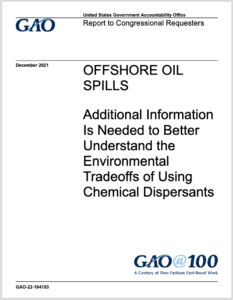Full Title: Offshore Oil Spills: Additional Information is Needed to Better Understand the Environmental Tradeoffs of Using Chemical Dispersants
Author(s): U.S. Government Accountability Office (GAO)
Publisher(s): U.S. Government Accountability Office (GAO)
Publication Date: December 15, 2021
Full Text: Download Resource
Description (excerpt):
In 2010, an explosion on an oil rig in the Gulf of Mexico resulted in 11 deaths and the largest oil spill in U.S. history.
Responders applied chemical dispersants to the surface oil slick—to break oil into smaller droplets. This can keep oil from reaching shoreline ecosystems, but may also increase toxic compound exposure for some sea life.
Responders also used dispersants at the wellhead, over 1,500 meters deep, without much information on the risks or effectiveness of doing so.
Subsurface dispersant use isn’t well understood. We recommended that the Coast Guard and EPA find ways to improve understanding of using dispersants below the surface.
